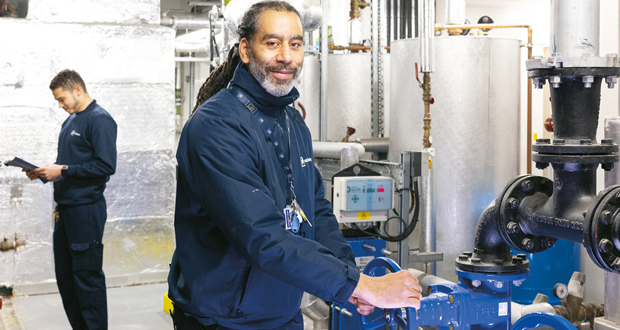 Smart digital maintenance combined with an actionable maintenance plan can drive better building performance, says Chris Coath, Director of Energy and Asset Management at NG Bailey
Smart digital maintenance combined with an actionable maintenance plan can drive better building performance, says Chris Coath, Director of Energy and Asset Management at NG Bailey
The concept of the smart building can still seem out of reach for many FMs. Contemplating this ‘bleeding edge’ terminology for the ageing buildings across most estates, and it appears both expensive and complex. We need to reset our view. A building is smart providing it contains appropriate levels of monitoring, control, and visibility of systems to maximise performance, optimise user comfort and support a net zero journey.
Smart buildings technology can be as simple or complex as needed. Commercial office buildings with thousands of assets can benefit from integrated BMS (Building Management System) and energy management systems, drawing on tools akin to Artificial Intelligence.
Conversely, many smaller buildings require a much leaner approach, blending solutions such as energy monitoring and IoT (Internet of Things). In both cases, there is a cost vs reward balance, so weighing up the potential benefits against deployment and ongoing operating costs is vital.
THE KEY TO NET ZERO?
Buildings are responsible for 39 per cent of global carbon emissions, with the vast majority (28 per cent) coming from operational emissions and the energy needed to power, heat and cool them. A 2021 survey by IWFM found that reducing energy and the carbon footprint of buildings is a key priority for 70 per cent of respondents, but the majority (62 per cent) said they didn’t have access to the data they needed to meet these sustainability goals.
To make a meaningful impact, we must start with improving building performance and reducing energy demand. It is now considered that commercial office buildings will need to reach an annual energy intensity of 70kWh/m2 [NLA] to achieve net zero targets. Many buildings will fall short of these levels due to the shortcomings of the fabric elements, but until that limit is reached, every kWh of energy waste should be targeted and every possible kg/CO2 should be saved.
Smart building technology can be a vital tool in meeting these targets.
DIGITAL MAINTENANCE
So, you have a net zero target and a smart building; but how do you extract the maximum potential of your assets? In many cases, even the smartest of buildings struggle to realise their potential, as the fundamental components of building operation and maintenance remain unchanged.
This is where digital maintenance can help. Driven by smart technology it unlocks the ‘under the bonnet’ insight of assets to help influence decisions, but most importantly, closes the gap between data and action.
At the core of digital maintenance remains a PPM (planned preventative maintenance) planner. Tailored to specific assets installed and inclusive of maintenance tasks completed remotely, the combined effect is a dynamic planner and an engineering team that spend less time on assets working reliably at peak performance, and instead invest more time on less reliable assets or those that have scope for optimisation.
It is also vital to recognise that all data needs interpretation. As such, integrating data analysts and energy managers into a wider engineering team is crucial to interpret, triage and track actions as they arise. The most effective relationship occurs when engineers and analysts work in collaboration to resolve issues, diagnose faults and measure benefits.
Digital maintenance should now be the default across the FM industry. It will help drive asset performance, allow customers to make rapid changes, and vitally increase the scale and pace of our journey towards achieving net zero.





